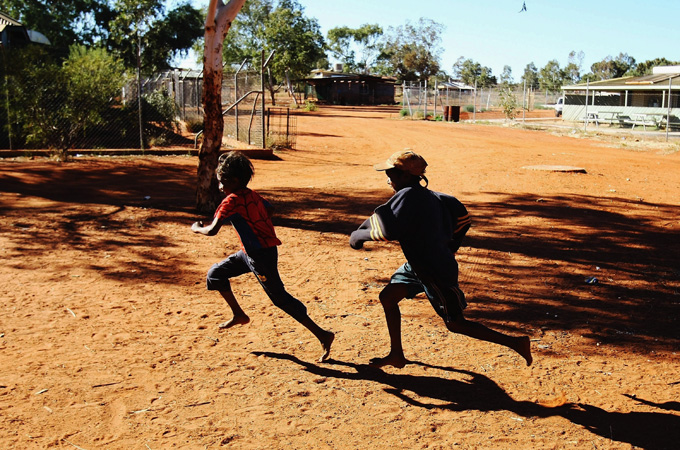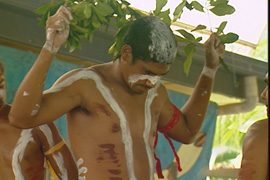Australia’s indigenous disadvantage problem
Rights advocates question sincerity of prime minister’s pledge to tackle aboriginal inequality.

On the electoral campaign trail in August 2012, Tony Abbott called on black and white Australians to “open their hearts to one another”. Then opposition leader he explained, “It is my hope that I could be not just the prime minister but the prime minister for Aboriginal affairs – the first one that we have ever had.”
This aspiration was reiterated last week when now Prime Minister Abbott delivered his first report on the federal initiative to tackle indigenous disadvantage. Launched in the aftermath of former-prime minister Kevin Rudd’s much-lauded 2008 apology to the Stolen Generation, “Closing the Gap” aims to bridge the divide between indigenous and non-indigenous Australia on a range of fronts, including life-expectancy, education and unemployment, within a generation.
The 2014 report renewed and broadened pre-existing targets, with Abbott claiming it was his government’s job to “break the tyranny of low expectation”.
“It is an honour to be following the tradition established by Kevin Rudd and I would be incredibly disappointed if in three to four years we had not continued to do even more and even better in this field,” he told parliament.
Abbott’s espoused “personal mission” to address inequities among Australia’s indigenous population – representing 2 percent of the country’s 23 million people – is a deviation from a more customary conservative sidelining of indigenous affairs.
It's hard to find work without a basic education, and it's hard to live well without a job.
Yet with escalating incarceration of aboriginal people, child-removal rates, and this week’s revelations of unequal pay in Abbott’s own office, many fail to perceive his leadership as a break from Australia’s darker record on indigenous policy.
Mixed report
Abbott’s up-beat forecast was accompanied by a series of “bad news” revelations about the general short-fall on “Closing the Gap’s” key targets. While the aim of halving the child mortality divide within a decade was reported on track, there has been little progress towards the 2031 goal of bridging the life-expectancy gap, which remains about 10-years lower for indigenous Australians.
Pre-school attendance rates were up, yet overall literacy had not improved since 2008. Abbott also reported negative progress on the 10-year plan to halve employment disparities.
However, non-governmental backers of the programme argue that sluggish progress on interlinked and often intractable challenges does not indicate failure.
“This is a long-term term effort of many years and over consecutive governments,” said Andrew Meehan, indigenous rights advisor at Oxfam Australia, one of pioneers of the health initiative behind the government’s broader “Closing the Gap” programme.
“The overall target is for 2030, so the most important thing is to ensure continued investment by all sides of parliament,” Meehan said.
He pointed to promising bipartisan support for the framework, but said such partnerships must extend to agreements with state governments and a more paramount engagement with indigenous communities themselves.
“Through our international development work, we know that it’s the people who are affected by policies who are best placed to have real input into what they should look like,” he told Al Jazeera.
“It’s very hard to separate any issue around inequality or disadvantage. Jobs, education, employment and housing are all linked social determinants of health.”
 |
| Aboriginal children play in Mutitjulu, near Alice Springs [GALLO/GETTY] |
Abbott has likewise highlighted the interdependence of “Closing the Gap” targets, in particular, links between general indigenous disadvantage and school attendance – a new emphasis of his government’s programme without which he claimed it would be “doomed to fail”.
“We are not on track to achieve the more important and the more meaningful targets, because it’s hard to be literate and numerate without attending school,” he said. “It’s hard to find work without a basic education, and it’s hard to live well without a job.”
Accordingly, his government set an ambitious new target to close the gap on school attendance within five years, attracting the support of the Labour opposition.
‘Obfuscating issues’
However, some observers suggested that Abbott’s rhetorical new support for indigenous equality is political gamesmanship that continues to airbrush the most dire areas of disadvantage.
Jon Altman, of the Australian National University’s Centre for Aboriginal Economic Policy Research, said the prime minister has adopted a cynical approach which, like previous governments, masks inequality with bureaucratic policy.
“Wanting to be the PM for indigenous affairs is just one-upmanship on Rudd,” Altman told Al Jazeera. “[Adding new targets] is a useful strategy, because if you’re failing on existing gaps, you invent new ones. Why not try to get some genuine traction on existing indicators, rather than obfuscating the real issues with new ones?”
The most disturbing gap, Altman said, was the staggering rate of indigenous incarceration and death in custody. More than 52 per cent of young people detained in Australia are indigenous, most of them unsentenced, and statistics have risen sharply since 2008 alongside deaths in custody.
Despite a 1991 Royal Commission into the issue, there has been little reform in the justice sector, nor any bipartisan agreement on tackling it. Another of Abbott’s election-eve promises was a pledge to slash $42 million from Aboriginal legal aid.
Altman said such disparities reflect a misguided, top-down approach that has failed to deliver outcomes over both Labour and Liberal governments.
 |
| Aboriginal students commemorate the first anniversary of former prime minister Kevin Rudd’s apology to indigenous Australians |
“There is no real consultation or framework beyond assimilate, absorb or be marginalised,” he said. “We have an assumption that what government thinks is good for indigenous people is good – that indigenous people are incapable of decision-making. Instead, the bureaucratic classes want easy, universal solutions to heterogeneous circumstances and diverse, embedded problems.”
Taking children
Communities on the receiving end of state and federal policies have echoed the view that the dominant political approach is culturally inappropriate and socially destructive. With a reported five-fold increase in indigenous child removal rates between 1997 and 2012, warnings are emerging of a “new Stolen Generation” across Australia, six years after the national apology.
Criticisms are particularly powerful in New South Wales state, where an estimated 6,000 children are in out-of-home care, and a group of activists last week marked the apology anniversary with a protest calling for an inquiry into welfare and police practices.
Speaking shortly after Abbott’s “Closing the Gap” address, “Aunty Hazel” of Grandmothers Against Removals said the prime minister’s pledges rang hollow while such practices were ongoing.
“It feels like you’ve been hit in the back by a sledgehammer hearing his words,” she told Al Jazeera. “This man does not understand indigenous culture and to have him controlling affairs would be the biggest mistake of all. It is an insult.”
Like many indigenous-rights advocates, Hazel, whose own family has been affected by removal policies, said current actions reflect the same ill-informed, punitive approach behind Australia’s indigenous social policies of the past century.
“Children are being stolen under the guise of protection as part of a wider assimilation approach,” she said. “We do not consider this a new phase, but a continuation of the stolen generation that’s existed since European settlement. We are a multicultural Australia with respect shown to people from all backgrounds, yet we continue to treat our own oldest people without basic humanity.”
Historical denial
Abbott himself highlighted the double-standards of Australia’s treatment of indigenous people in his “Closing the Gap” address. Calling his country “the best on Earth”, the prime minister argued that Australia could not meet its full potential while such inequities persisted.
Thirty-years ago incarceration rates were so bad that they were seen to warrant a Royal Commission. And now when they are even worse, nothing is said.
“There is no country on Earth where people are made more welcome,” he told parliament. “Yet for two centuries … Australians had collectively failed to show to Aboriginal people the personal generosity and warmth of welcome that we have habitually extended to the stranger in our midst.“
Indigenous supporters of “Closing the Gap” have welcomed the prime minister’s words and called on the government to ensure that the current generation of Australians sees an end to this imbalance.
Responding to last week’s report, Mick Gooda from the Australian Human Rights Commission said, “We can make real inroads in the national effort to close the gap if we continue to place a high priority on it.”
But as the nation celebrated the anniversary of Rudd’s hailed apology, others argued Australia is as far as ever from recognising the disadvantage of its first people.
“Thirty-years ago incarceration rates were so bad that they were seen to warrant a Royal Commission, and now when they are even worse, nothing is said,” said Gary Foley, an aboriginal activist and academic at Victoria University.
Foley, who is renowned for his role in pioneering the 1970s Aboriginal Tent Embassy movement, said the actions of both Abbott and his predecessor Rudd reflect a skewed view of Australian history that continues to shape indigenous policy.
“Nobody is really asking why indigenous kids don’t want to go to school,” he told Al Jazeera. “It is because of the assimilationist nature of the education system, and it is because of the historic denialism that is taught by our schools that deters Aboriginal parents and students. It is not because parents prefer to be drunk.”